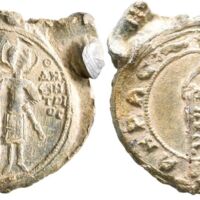Johannes Gabras
Reference Description
Johannes Gabras, late 12th to first half 13th century. Seal (Lead, 50 mm, 48.06 g, 12 h). [...] - Θ ΔH/MH/TPI/OC Saints Georgios, on the left, and Demetrios, on the right, both standing facing, nimbate, wearing military attire and holding spears; Saint Georgios is resting his left hand on a shield, Saint Demetrios is holding his scabbard. Rev. +[IⲰA]NNHC O ΓARPAC Large monogram of ΓABPA. SBS 10, p. 105, no. 3. Cf. Seibt/Zarnitz 1.2.8 (with the dignity of sebastos). A large and impressive late Byzantine seal. Light doubling and with minor marks. Good very fine.
The ethnic origins of the Gabras family are somewhat unclear. Their family name perhaps derives from Aramaic (‘man’ or ‘heros’), Armenian (‘brave’) or even Arabic (‘kafir’, unbeliever, a name that might make sense for a Christian family in the Muslim borderlands). Whatever their origin may be, the family became part of the Byzantine aristocracy during the 11th century, making their careers as military officers. After Theodore Gabras, one of the most famous members of the family, recaptured the city of Trebizond from the Turks in 1075, the family established themselves as the main power in the region and attempted to establish a semi-autonomous realm. Our Johannes Gabras may be identified with a pansebastos sebastos Johannakios Gabras named in documentary sources for March 24th 1216 concerning a donation to the monastery of St. Paul of Latros.
The important Armenian family of the Gabras.
The ethnic origins of the Gabras family are somewhat unclear. Their family name perhaps derives from Aramaic (‘man’ or ‘heros’), Armenian (‘brave’) or even Arabic (‘kafir’, unbeliever, a name that might make sense for a Christian family in the Muslim borderlands). Whatever their origin may be, the family became part of the Byzantine aristocracy during the 11th century, making their careers as military officers. After Theodore Gabras, one of the most famous members of the family, recaptured the city of Trebizond from the Turks in 1075, the family established themselves as the main power in the region and attempted to establish a semi-autonomous realm. Our Johannes Gabras may be identified with a pansebastos sebastos Johannakios Gabras named in documentary sources for March 24th 1216 concerning a donation to the monastery of St. Paul of Latros.
The important Armenian family of the Gabras.
Provenance
Leu 7 Lot 1990
23.10.2020
23.10.2020
Archive Category
Citation
“Johannes Gabras,” Armenian Numismatic Research Organization, accessed June 5, 2025, http://armnumres.org/items/show/1248.


